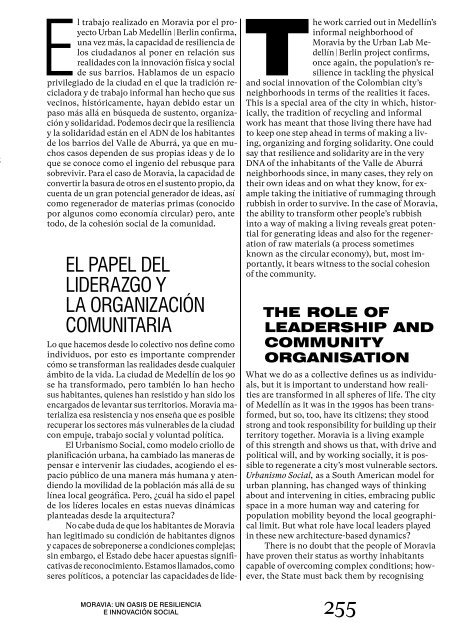Moravia Manifesto – Coding Strategies for Informal Neighborhoods
ISBN 978-3-86859-535-2 https://www.jovis.de/en/books/details/product/moravia-manifesto.html
ISBN 978-3-86859-535-2
https://www.jovis.de/en/books/details/product/moravia-manifesto.html
- No tags were found...
Create successful ePaper yourself
Turn your PDF publications into a flip-book with our unique Google optimized e-Paper software.
El trabajo realizado en <strong>Moravia</strong> por el proyecto<br />
Urban Lab Medellín | Berlin confirma,<br />
una vez más, la capacidad de resiliencia de<br />
los ciudadanos al poner en relación sus<br />
realidades con la innovación física y social<br />
de sus barrios. Hablamos de un espacio<br />
privilegiado de la ciudad en el que la tradición recicladora<br />
y de trabajo in<strong>for</strong>mal han hecho que sus<br />
vecinos, históricamente, hayan debido estar un<br />
paso más allá en búsqueda de sustento, organización<br />
y solidaridad. Podemos decir que la resiliencia<br />
y la solidaridad están en el ADN de los habitantes<br />
de los barrios del Valle de Aburrá, ya que en muchos<br />
casos dependen de sus propias ideas y de lo<br />
que se conoce como el ingenio del rebusque para<br />
sobrevivir. Para el caso de <strong>Moravia</strong>, la capacidad de<br />
convertir la basura de otros en el sustento propio, da<br />
cuenta de un gran potencial generador de ideas, así<br />
como regenerador de materias primas (cono cido<br />
por algunos como economía circular) pero, ante<br />
todo, de la cohesión social de la comunidad.<br />
EL PAPEL DEL<br />
LIDERAZGO Y<br />
LA ORGANIZACIÓN<br />
COMUNITARIA<br />
Lo que hacemos desde lo colectivo nos define como<br />
individuos, por esto es importante comprender<br />
cómo se trans<strong>for</strong>man las realidades desde cualquier<br />
ámbito de la vida. La ciudad de Medellín de los 90<br />
se ha trans<strong>for</strong>mado, pero también lo han hecho<br />
sus habitantes, quienes han resistido y han sido los<br />
encargados de levantar sus territorios. <strong>Moravia</strong> materializa<br />
esa resistencia y nos enseña que es posible<br />
recuperar los sectores más vulnerables de la ciudad<br />
con empuje, trabajo social y voluntad política.<br />
El Urbanismo Social, como modelo criollo de<br />
planificación urbana, ha cambiado las maneras de<br />
pensar e intervenir las ciudades, acogiendo el espacio<br />
público de una manera más humana y atendiendo<br />
la movilidad de la población más allá de su<br />
línea local geográfica. Pero, ¿cuál ha sido el papel<br />
de los líderes locales en estas nuevas dinámicas<br />
planteadas desde la arquitectura?<br />
No cabe duda de que los habitantes de <strong>Moravia</strong><br />
han legitimado su condición de habitantes dignos<br />
y capaces de sobreponerse a condiciones complejas;<br />
sin embargo, el Estado debe hacer apuestas significa<br />
tivas de reconocimiento. Estamos llamados, como<br />
seres políticos, a potenciar las capacidades de lide<br />
MORAVIA: UN OASIS DE RESILIENCIA<br />
E INNOVACIÓN SOCIAL<br />
The work carried out in Medellín’s<br />
in<strong>for</strong>mal neighborhood of<br />
<strong>Moravia</strong> by the Urban Lab Medellín<br />
| Berlin project confirms,<br />
once again, the population’s resilience<br />
in tackling the physical<br />
and social innovation of the Colombian city’s<br />
neighborhoods in terms of the realities it faces.<br />
This is a spe cial area of the city in which, historically,<br />
the tradition of recycling and in<strong>for</strong>mal<br />
work has meant that those living there have had<br />
to keep one step ahead in terms of making a living,<br />
organ izing and <strong>for</strong>ging solidarity. One could<br />
say that resilience and solidarity are in the very<br />
DNA of the inhabitants of the Valle de Aburrá<br />
neighbor hoods since, in many cases, they rely on<br />
their own ideas and on what they know, <strong>for</strong> example<br />
taking the initiative of rummaging through<br />
rubbish in order to survive. In the case of <strong>Moravia</strong>,<br />
the ability to trans<strong>for</strong>m other people’s rubbish<br />
into a way of making a living reveals great potential<br />
<strong>for</strong> gen erating ideas and also <strong>for</strong> the regeneration<br />
of raw materials (a process sometimes<br />
known as the circular economy), but, most importantly,<br />
it bears witness to the social cohesion<br />
of the community.<br />
THE ROLE OF<br />
LEADERSHIP AND<br />
COMMUNITY<br />
ORGANISATION<br />
What we do as a collective defines us as individuals,<br />
but it is important to understand how realities<br />
are trans<strong>for</strong>med in all spheres of life. The city<br />
of Medellín as it was in the 1990s has been trans<strong>for</strong>med,<br />
but so, too, have its citizens; they stood<br />
strong and took responsibility <strong>for</strong> building up their<br />
territory together. <strong>Moravia</strong> is a living example<br />
of this strength and shows us that, with drive and<br />
political will, and by working socially, it is possible<br />
to regenerate a city’s most vulnerable sectors.<br />
Urbanismo Social, as a South American model <strong>for</strong><br />
urban planning, has changed ways of thinking<br />
about and intervening in cities, embracing public<br />
space in a more human way and catering <strong>for</strong><br />
population mobility beyond the local geographical<br />
limit. But what role have local leaders played<br />
in these new architecture-based dynamics?<br />
There is no doubt that the people of <strong>Moravia</strong><br />
have proven their status as worthy inhabitants<br />
capable of overcoming complex conditions; however,<br />
the State must back them by recognising<br />
255


















